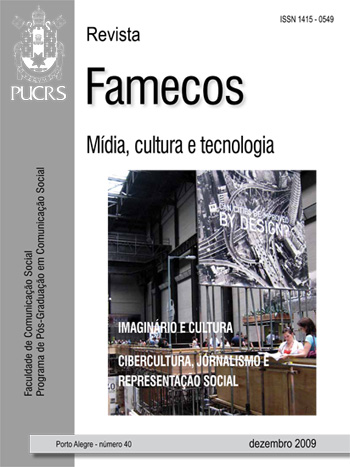Cultura da Mobilidade
DOI:
https://doi.org/10.15448/1980-3729.2009.40.6314Palavras-chave:
Mobilidade, comunicação, ciberculturaResumo
A mobilidade é inerente ao homem, sendo correlata à necessidade de criar um lugar no mundo, de “construir para habitar” (Heidegger, 1958), de estabelecer um topus que nos proteja da solidão e do vazio do espaço genérico e abstrato. A cultura da mobilidade entrelaça questões tecnológicas, sociais, antropológicas. Para a comunicação, a mobilidade é central já que comunicar é fazer mover signos, mensagens, informações, sendo toda mídia (dispositivos, ambientes e processos) estratégias para transportar mensagens afetando nossa relação com o espaço e o tempo. Na atual fase das tecnologias da mobilidade e de localização (as mídias locativas), não se trata tanto de aniquilar os lugares, mas de criar espacializações. Esta é a tese aqui defendida. A atual cultura da mobilidade é uma cultura locativa.
Downloads
Referências
ADORNO, Theodor. Minima moralia. Paris: Payot, 1980.
ATTALI, Jacques. L’Homme nomade. Paris: Fayard, 2003.
BHABHA, Homi K. The location of culture. Londres: Routledge, 1994.
BAUMAN, Zygmunt. Modernidade líquida. RJ: Zahar, 2001.
CAIAFA, Janice. A aventura das cidades. Ensaios e etnografias. Rio de Janeiro: FGV, 2007.
CARON, André e CARONIA, Letizia. Culture mobile. Montreal: Presses de l’Université de Montreal, 2005.
CASTELLS, Manuel, et al. Mobile communications and society. A Global Perspective. Cambridge: MIT Press, 2007.
DOURSIH, Paul; et alli. Culture mobilities. Diversity and Agency in Urban Computing. USA, 2007.
DELEUZE, Gilles; GUATTARI, Félix. Mille plateaux. Capitalisme et Schizophrénie. Paris: Les Editions de Minuit, 1980.
FOUCAULT, Michel. De outros espaços. In: Architecture, Mouvement, Continuité, 1984. Disponível em: http://www.rizoma.net/interna.php?id=169&secao=anarquitextura Acesso em: 11. dez. 2008.
AYDEN, Florian; TEMEL, Robert. Temporary Urban Spaces. Basel: Birkhäuser, 2006.
HEIDEGGER, Martin. Bâtir habiter penser. In: Essays et Conférences, Paris: Gallimard, 1958.
KATZ, James. & Aakhus, Mark. Perpetual Contact: Mobile Communication, Private Talk, Public Performance. Cambridge: University Press, 2002.
KATZ, James. E (Ed). Handbook of mobile communication studies. Massachusetts: MIT, 2008.
KELLERMAN, Aharon. Personal Mobilities. Nova Iorque: Routledge, 2006.
KOSKINEN, Ilpo. Seeing with Mobile Images. Toward Perpetual Visual Contact. In: The Global and the Local in Mobile Communication: Places, jun. 2004.
KWAN, Mei-Po. Mobile communication, Social Networks, and Urban Travel: Hypertext as a New Metaphor for Conceptualizing Spatial Interaction. In: The Professional Geographer, v. 59, n. 4, nov. 2007.. Washington, p. 434-446.
LATOUR, Bruno. Reassembling the social. An Introduction to Actor-Network-Theory. Oxford, 2005.
LEFEBVRE. Henri. The Production of space. Blackwell Publishing, 1991.
LEMOS, André. Locative media in Brazil. In: Wi. Journal of Mobile Media. Montreal/Toronto: Summer, 2009.
LEMOS, André. Mobile Communication and New Sense of Places: a critique of spatialization in cyberculture. In Galáxia, n. 18, dez. 2008, PUC-SP, p. 91-108.
LING, Rich. The mobile connection. The cell phones impact on society. San Franscisco, 2004.
MAFFESOLI, Michel. Du nomadism. Vagabondages Initiatiques. Paris: Librarie Générale Française, 1997.
MASSEY, Doreen. A Global sense of place. In: Readings Human Geography, Trevor Barnes and Derek Gregory. (Eds) London: Arnold, 1997, p. 315-323.
MEAD, George. Mind, self, and society: from the standpoint of a social behaviorist. Chicago: University of Chicago Press, 1967.
MEYROWITZ, Joshua. No sense of place. The impact of electronic media on social behavior. London: Oxford University Press, 1985.
MUMFORD, Lewis. A Cidade na História. Suas origens, transformações e perspectivas. São Paulo: Martins Fontes, 1988.
NYÍRI, Kristóf. A sense of place. The global and the local in mobile communication. Viena: Passagen Verlag, 2005.
SERRES, Michel. Les messages à distance. Montréal: Editions Fides, 1995.
SHIELDS, Rob. Places on the margin. Alternative geographies of modernity. London: Routledge, 1991.
SHIRVANEE, Lily. Locative viscosity: Traces of social histories In: Public Space, 20016. Disponível em: http://leoalmanac.org/journal/vol_14/lea_v14_n03-04/lshirvanee.asp Acesso em: 13 dez. 2008.
SIMMEL, Georg. La tragédie de la culture. Paris: Rivage poche, 1988.
SOROKIN, Pitirim. Social and cultural mobility. London: Collier -Macmilliam Limited, 1964.
THRIFT, Nagel. Steps to an Ecology of Place. In Human Geography Today, Doreen Massey, John Allen and Philip Sarre (Eds) Cambridge: Polity Press, 1999, p. 295-322.
TUAN, Yi-Fu. Space and place. The Perspective of Experience. Minneapolis/London: University of Minnesota Press, 2003.
URRY, John, et al. Mobilities, immobilities and moorings. In: Mobilities, 1, Londres: Routledge, 2006.
URRY, John & Sheller, Mimi. Mobile technologies and the city. Londres: Routledge, 2006.
URRY, John. Sociology Beyond Societies. Mobilities for the twenty-first century. London: Routlegde, 2000.
Downloads
Como Citar
Edição
Seção
Licença
Direitos Autorais
A submissão de originais para a Revista Famecos implica na transferência, pelos autores, dos direitos de publicação. Os direitos autorais para os artigos publicados nesta revista são do autor, com direitos da revista sobre a primeira publicação. Os autores somente poderão utilizar os mesmos resultados em outras publicações indicando claramente a Revista Famecos como o meio da publicação original.
Licença Creative Commons
Exceto onde especificado diferentemente, aplicam-se à matéria publicada neste periódico os termos de uma licença Creative Commons Atribuição 4.0 Internacional, que permite o uso irrestrito, a distribuição e a reprodução em qualquer meio desde que a publicação original seja corretamente citada.






